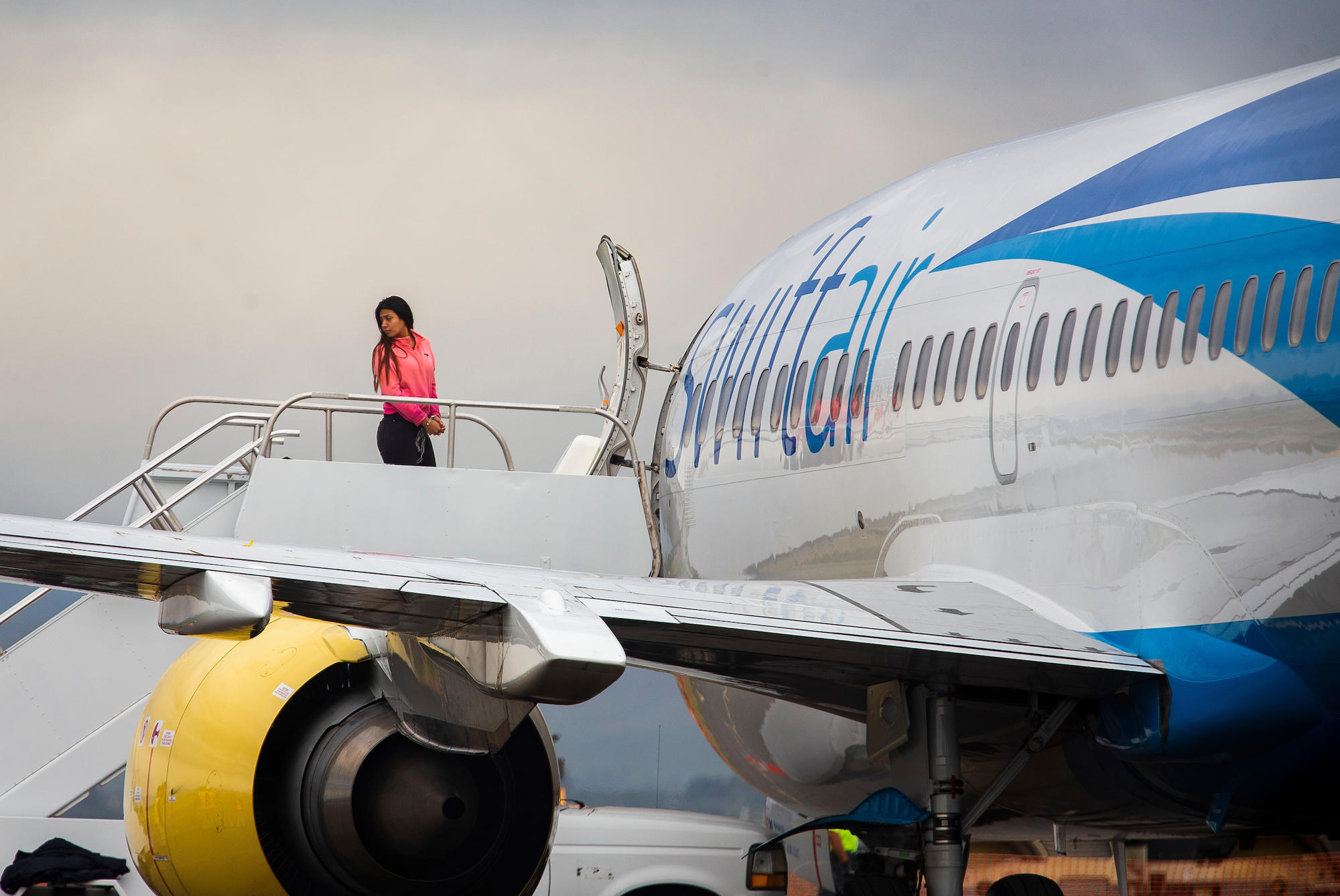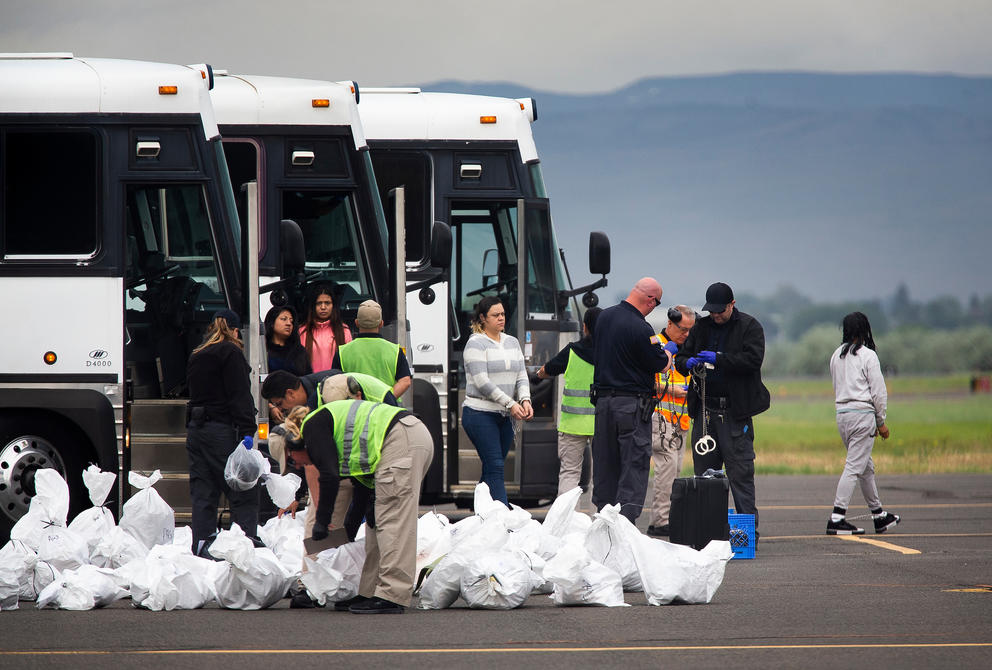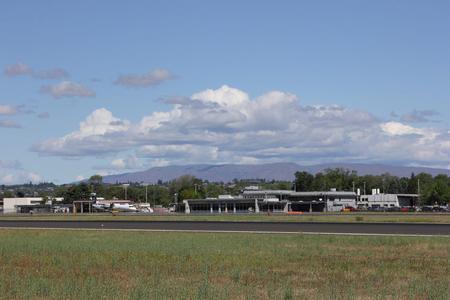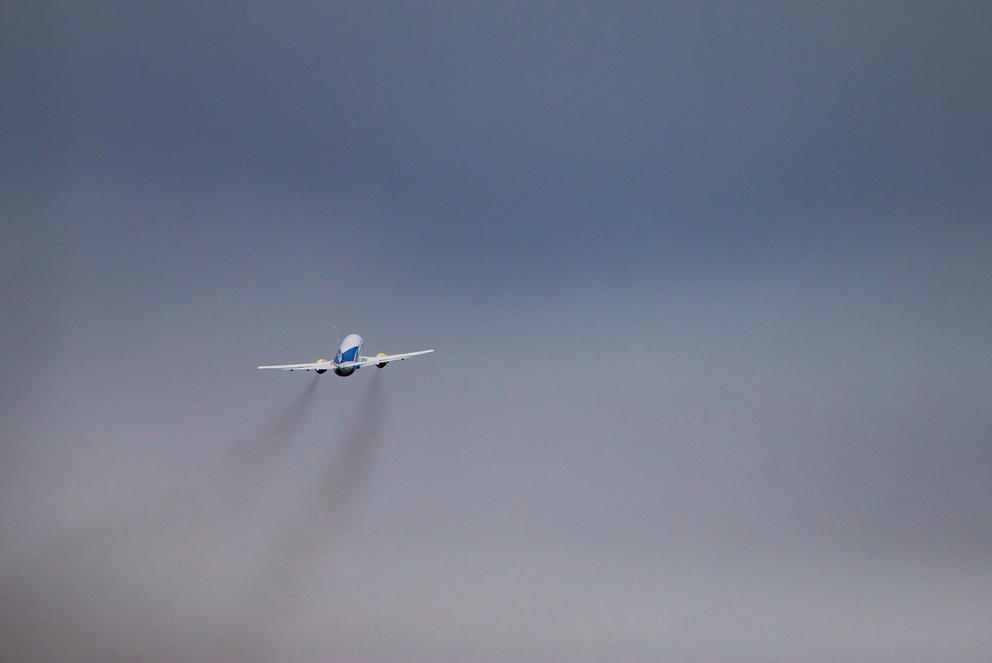Just outside the fence separating the tarmac from a Hertz car rental parking lot, members of the Yakima Immigrant Response Network held up a sign for the detainees to read. Written on it were the words “te apoyamos,” or “we support you.”
The members of the advocacy group, formed after the election of President Donald Trump, watched as the detainees, in chains, climbed the stairs leading up to the airplane’s door.
“You can’t even hold on to the railing on the stairs to prevent yourself from falling,” said one member of the Yakima Immigrant Response Network, a handful of whom have observed previous deportation flights.
The city’s new police chief, Matt Murray, stood in front of the activists, just beyond the fence, watching.
“We don’t have a position either way. It’s just public safety we’re concerned with,” Murray said when asked about the flights.
In the approximately two weeks since U.S. Immigration and Customs Enforcement resumed deportation flights to Yakima, 231 detainees arriving by bus have boarded a plane headed for various hubs in the Southwest: El Paso, Texas; Las Vegas, Nevada; Mesa, Arizona, said Yakima’s city manager Cliff Moore. Ultimately, the detainees will be deported to various parts of the world. At the same time, 218 people have been transferred from these flights to buses bound for the Northwest Detention Center in Tacoma, approximately 150 miles from the airport.
Moore also has spent time observing the transfers at the city-operated airport. He says the majority of the detainees he has seen boarding the deportation flights and the westbound buses are men, but that roughly 30 percent are women — most in their 20s and 30s. ICE officials have said that those bound for the Northwest Detention Center in Tacoma are asylum seekers whose cases are pending, while those being deported have been denied asylum — forced to return to their home countries.
Aspects of immigration enforcement have been increasingly questioned under the Trump administration. This is in part a result of some of the administration’s more controversial tactics, such as family separation, in which undocumented parents were separated from their children at the southern border. Although ICE Air flights occurred under former President Barack Obama, they have recently come under increased scrutiny. ICE argues that the flights are necessary to remove dangerous criminals. According to ICE’s own statistics, however, approximately half of those removed last year had no criminal record.
The flights to Yakima Air Terminal began just days after ICE Air flights into and out of Seattle’s King County International Airport, otherwise known as Boeing Field, were discontinued.
All three of that airport’s fixed-base operators, which provide fuel and other services to airplanes, opted to stop servicing ICE flights after King County Executive Dow Constantine announced he planned to halt such flights at the county-operated airport. Constantine first pledged to shut down the flights in 2018, but didn’t make good on that promise until a report last month from the University of Washington Center for Human Rights revealed that 34,400 detainees had been deported from Boeing Field in the past eight years.
Constantine’s promise, however, has prompted pushback and, federal officials warn, could lead to serious consequences. On May 1, the U.S. Department of Transportation wrote to Constantine, noting that federal law prohibits withholding services from flights that help carry out immigration proceedings. Specifically, the department pointed to the Airline Deregulation Act of 1978, which, according to the letter, prevents local and state government from placing restrictions on certain routes. The letter also noted that since 2012, King County has received $21 million in federal grant money for airport improvements.
When asked whether King County had made itself vulnerable to litigation or restrictions on funding, a Federal Aviation Administration spokesperson would only say: “The DOT letter speaks for itself.”
Tanya Roman, the Pacific Northwest spokesperson for ICE, has confirmed that, due to Constantine’s directive, ICE Air will continue to operate in Yakima indefinitely. In an email Roman noted that “this move has caused a significant increase in both the cost to taxpayers and travel time for detainees.”
Now, Yakima must decide whether it will allow the deportation flights to continue or, like King County, pressure the airport’s single fixed-base operator, McCormick Air Center, to stop servicing the flights. When asked about the ICE Air flights, Theresa Hart, McCormick's operations manager, said in an email: "McCormick Air Center does not comment on its customers."
Some in Yakima see the challenge to halt ICE Air flights as a moral test, which pits much of the city’s large immigrant community, a good portion of whom work in the region’s robust agricultural industry, against city leaders worried about money and those who see the deportation flights as a necessary part of the country’s checks on immigration.
Although Yakima is almost 50 percent Latino, it is politically more conservative than Seattle: While more than 50 percent of Washington state voted for Hillary Clinton in the 2016 presidential race, the majority of Yakima County chose Trump. But identity does not necessarily dictate personal political leanings here. Some advocates point out that Latinos in the county tend to have a diversity of views on matters concerning immigration, with some, particularly later generations, complaining about the recent arrival of those who have come to the country illegally.
Whatever the political will of the people or the city of Yakima, City Manager Moore said his hands are tied when it comes to ICE Air. He points to both the airport’s agreement with the FAA and the airport’s lease with McCormick Air Center, which notes that the “lessee agrees to comply with all applicable laws … of all governmental authorities having jurisdiction over the airport.”
“We would essentially be saying to them that you have to violate your contract,” Moore said. “Regardless of how I feel about it personally, I don’t see that we have much of a legal leg to stand on.”
Moore said he believes Constantine and other King County officials will eventually be forced to walk back their decision to not work with ICE.
“He may be doing this to prove a point with the knowledge he has to take this on in litigation,” Moore said. “My job is to represent the best interests of the city of Yakima.”
“I think he’s put King County in an awkward position here,” Moore said.
There is also the matter of city funding. Robert Peterson, manager of Yakima Air Terminal, explained that the airport makes approximately $200 in landing fees whenever a large plane, such as the Boeing 737 aircrafts carrying immigrants, land there. Peterson and Moore also say the approximately $18 million in federal grant funding the city has received in the past eight years would be at risk if they followed in King County’s footsteps.
Others, however, are less concerned about possible monetary losses.
It’s the “same old story, profit over people,” said Michele Nelson Janke of the Yakima Immigrant Response Network.
Members of the group say they will continue to observe ICE Air flights, which land approximately twice a week after Swift Air provides the airport with 24-hour notice. The organization says airport officials so far have not prevented them from doing so, but that they believe the group's presence makes a difference in the way detainees are treated and to the detainees themselves.
When the detainees see the observers and their sign, they may think, “Maybe there’s somebody out there that really cares about them in the Yakima community,” one member said, noting that the group already has raised certain issues to Moore, such as whether detainees have access to toilets.
“Let’s treat them like human beings; they’re not animals,” she added. (Moore confirmed the detainees have bathroom access though they remain shackled.)
There have been some reports of abuse during these flights. In 2017, dozens of passengers joined a class-action lawsuit and sued the federal government over the alleged mistreatment.
That same year, passengers on an ICE Air flight from El Paso to Somalia, including some from King County, were allegedly beaten, kicked, threatened, denied access to the bathroom and placed in full-body restraints. According to the UW Center for Human Rights report, some of those denied access to bathrooms reportedly soiled themselves in their seats.
Prior to the arrival of the ICE Air flights, advocates have had some success in limiting ICE's operations in the area. In February, for example, Yakima County agreed to no longer hold inmates for ICE after they are eligible to be released from jail, the result of an effort led by Columbia Legal Services and the Northwest Immigrant Rights Project. Yakima County, however, continues to have an intergovernmental agreement with the federal government, which permits the county jail to hold people when they are brought in by immigration officers.
With regard to ICE Air flights, Columbia Legal Services attorney Alfredo Gonzalez says his organization is still exploring options.
“The city is complicit in human rights abuses by allowing ICE to use the airport,” Gonzalez said. “This is a fundamental moral issue.”
“The city’s actions are having a chilling effect on our large immigrant community,” he said. “Our hope is the city of Yakima values the safety and contribution of our immigrant community and will stop participating in the deportations of our families.”
City Manager Moore said he has heard from community members concerned about the flights. Some worry that the flights will lead to more immigration officials on the ground. Moore said the agency has assured him that isn’t the case.
Mike Gempler of the Washington Growers League, which provides labor and employment services for agricultural employers, said agriculture business owners seem to understand that “there’s been no real change in policy” and that so-called I-9 audits, which check for undocumented immigrants working in agricultural fields, will continue at the same rate they had before the flights began landing.

But Rocío Carrión, a 32-year-old recipient of DACA, or Deferred Action for Childhood Arrivals, and a member of a committee that advises the Yakima City Council on issues of inclusivity, says she and others fear damage to the reputation of the region may have already been done.
Carrión says she’s heard others refer to Yakima as the “deportation city.” She and other members of the committee plan to “challenge the city council and push them to figure out another solution.” Carrión noted, however, that last year’s debate on whether to make Yakima a so-called sanctuary city proved controversial and was ultimately dropped.
If the Yakima City Council meeting on Tuesday is any indication, debates surrounding the ICE Air flights in the Central Washington community could also prove to be heated.
“If King County can stop the flights from Seattle, so can Yakima,” one person declared at the city’s most recent council meeting.
About 50 people sitting in the pews erupted in applause. Mayor Kathy Coffey asked that they stop.
“We need border control, but it needs to be rational and humane,” another person testified. Another member of the community compared the ICE Air flights to “Gestapo tactics.”
“This does not represent our values here in Central Washington,” cried another.
“My family doesn’t even want to drive by the airport anymore,” another person said.
“It’s all about money,” said one person. “A few big shots are making a lot of money off of locking people up, and I don’t like it. I don’t like it one bit.”
The most emotional testimony came from Celena Barajas, who, with heavy sighs, testified that she had been “personally victimized by ICE.”
Her own father had been deported to Mexico, she explained. He died there, she said, alone. Barajas broke down in tears.
“It’s painful. It’s painful,” she cried, referring to both her dad’s passing and the ICE Air flights. “I see my dad in those people and these are humans.”
The Yakima Immigrant Response Network asked that the city council adopt a resolution that would stop the ICE Air flights.
“Shut it down! Shut it down!” the crowd shouted.
City Councilmember Kay Funk asked that the matter be taken up at a later meeting.
But no other council member voted in favor of discussing the ICE Air flights at a later date.








